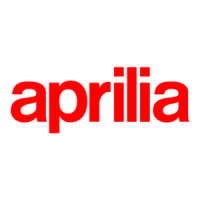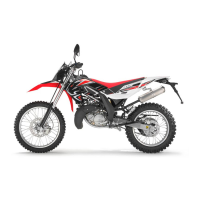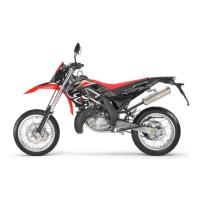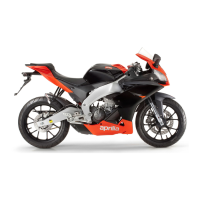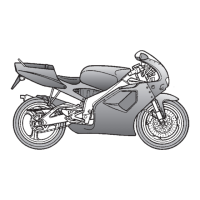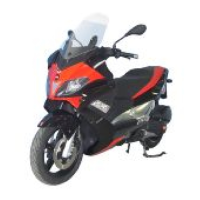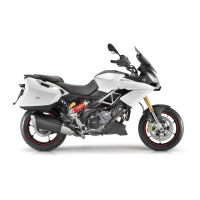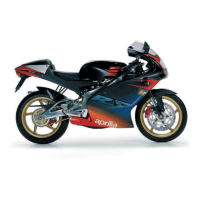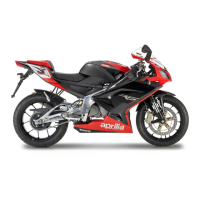Do you have a question about the APRILIA Classic 125 and is the answer not in the manual?
Instructions marked by warning signs for safety and technical information, plus symbols for vehicle versions.
Location and importance of the spare parts identification label for ordering parts.
Essential legal and personal requirements for safe vehicle operation, including licensing and condition.
Requirements for wearing a correctly fastened and homologated crash helmet for safety.
Wearing light or reflecting clothing for visibility and protection against falls.
Ensuring clothing is tight-fitting and avoids loose items that could interfere with driving.
Owner's responsibility for choosing, installing, and using accessories safely.
Avoiding electrical overloads by not modifying existing systems or using unsuitable devices.
Proper loading of luggage for vehicle balance, security, and stability during travel.
Identification of main vehicle components via numbered labels on the diagram.
Identification of main vehicle components and controls via numbered labels.
Identification of all controls located on the handlebars.
Identification of dashboard instruments and warning lights with their symbols.
Details and operation of the controls located on the left side of the handlebar.
How to operate the headlight switch for different light settings (off, parking, low/high beam).
Function and operation of the start push button and engine stop switch.
Operation and function of the ignition switch and steering lock mechanism.
Contents and location of the vehicle's standard tool kit.
Information on fuel type, tank capacity, and refueling safety precautions.
Accessing and using the under-seat storage compartment for helmets or gloves.
Guidelines for transmission oil checks, replacement intervals, and disposal.
Details on the mixer oil tank capacity, reserve level, and warning light.
Advice on brake lever issues and hydraulic system checks.
Procedure for checking and topping up the front brake fluid level.
Recommendations for brake fluid replacement and system bleeding.
Steps to adjust the rear brake lever and stoplight switch for optimal function.
Steps to remove the oil pan guard for access to the engine.
Adjusting clutch lever stroke for proper engagement and disengagement.
Procedure for more complex clutch adjustment if lever adjustment is insufficient.
Guidance on coolant changes, leak checks, and contact for service.
Procedure for checking and topping up coolant levels correctly.
Adjusting the position of the shifting lever for comfortable gear changes.
Recommended tyre inflation pressures for solo rider and rider with passenger.
Importance of checking tyre tread depth and overall condition for grip and safety.
Warnings about the hot catalytic converter and precautions for parking near flammable materials.
How the catalytic converter works and optimal usage conditions for efficiency.
A comprehensive checklist for pre-ride safety checks to ensure proper function.
Step-by-step guide for safely starting the engine, including fuel cock and ignition.
Using the cold start lever and procedures for starting a flooded engine.
Final checks before starting to ride, including mirrors, stands, and passenger instructions.
How to start moving, shift gears smoothly, and brake effectively for control.
Why engine break-in is crucial for longevity and performance.
Recommended speed limits and RPM during the running-in period for different mileage intervals.
How to safely decelerate, stop, and park the motorcycle securely.
Recommendations for preventing vehicle theft using locks and safe parking practices.
Safety precautions and preparations required before performing any maintenance.
Chart detailing scheduled maintenance tasks and their recommended intervals.
Location and importance of the engine number stamping on the engine block.
Location and importance of the frame number stamping on the steering column.
How to check the chain slack for proper tension and alignment.
Procedure for adjusting chain tension using the rear wheel adjusters.
What to look for when checking chain, pinion, and crown wear.
Recommended lubrication and cleaning procedures for the drive chain.
How to accurately check the transmission oil level using the sight glass.
Steps for safely draining and refilling the transmission oil.
Steps for safely removing the front wheel, including brake caliper precautions.
Steps for correctly reinstalling the front wheel, ensuring brake function.
Steps for safely removing the rear wheel, including brake cable and chain detachment.
Steps for correctly reinstalling the rear wheel, ensuring brake and chain alignment.
Steps for safely disconnecting and removing the fuel tank, including fuel line and electrical connections.
How to clean and re-oil the air filter element safely.
Procedures for checking front and rear suspension functionality and oil levels.
Adjusting rear suspension spring preload for rider weight and road conditions.
Adjusting shock absorber position for ride attitude and road surface.
How to visually check the wear on the front brake pads.
How to check the wear on the rear brake shoes.
Procedure for checking steering for looseness and ensuring smooth handlebar rotation.
Adjusting accelerator cable slack for proper throttle and lubrication pump function.
How to adjust the engine's idle speed for smooth and consistent running.
Steps to remove air from the mixer oil system to prevent engine damage.
Procedures for removing, cleaning, checking gap, and replacing spark plugs.
How to check and maintain the battery's electrolyte level.
Detailed steps for checking and topping up battery electrolyte safely.
Precautions for battery care during periods of inactivity and long-term storage.
How to check and replace blown fuses safely, identifying correct amperage.
How to adjust the headlight beam direction for optimal visibility on the road.
Step-by-step guide to safely replace headlight bulbs, including precautions.
How to replace bulbs in the instrument panel and warning light units.
Steps to replace the rear light bulb, including bulb orientation.
Procedure to replace the number plate bulb and light unit.
Steps to replace front and rear direction indicator bulbs carefully.
How to prepare the vehicle for safe transportation, including draining fluids.
Recommended methods and precautions for cleaning the vehicle, avoiding high-pressure jets.
Steps to take before storing the vehicle for extended periods to prevent issues.
Steps to prepare the vehicle after a long period of inactivity, including checks and test ride.
Specifications for vehicle overall dimensions, wheelbase, and ground clearance.
Details on engine type, displacement, bore/stroke, and fluid capacities.
Specifications for gearbox, gear ratios, and drive ratios for different versions.
Information on carburettor model, choke tube, and recommended fuel types.
Details on frame type, steering angle, and suspension travel.
Information on brake systems, wheel sizes, rim types, and tyre dimensions.
Specifications for ignition system, spark advance, spark plug gap, and idle rpm.
Details on battery, fuses, generator, and all light bulbs used in the electrical system.
List of recommended oils, greases, brake fluid, and engine coolant with specifications.
Contact details for the Aprilia UK importer.
Contact details for the Ideal Motor Sport Pte Ltd, Singapore.
Contact details for Aviram & Goldman Import & Marketing Co. Ltd, Israel.
Numerical key to components shown in the wiring diagram.
List of numbered electrical components and their descriptions.
Key to cable colours used in the wiring diagram for easy tracing.
Numerical key to components shown in the wiring diagram for the 11 kW version.
List of numbered electrical components and their descriptions for the 11 kW version.
Key to cable colours used in the wiring diagram for the 11 kW version.
| Engine Type | Single cylinder, two-stroke |
|---|---|
| Cooling System | Liquid cooled |
| Fuel System | Carburetor |
| Ignition | Electronic |
| Front Suspension | Telescopic fork |
| Rear Suspension | Monoshock |
| Front Brake | Disc |
| Rear Brake | Drum |
| Dry Weight | 118 kg |

